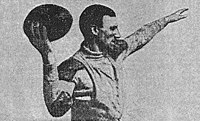
In American football, a spiral is the continuous in-flight rotation around the longitudinal axis of a football following its release from the hand of a passer [2] [3] or foot of a punter.

In American football, a spiral is the continuous in-flight rotation around the longitudinal axis of a football following its release from the hand of a passer [2] [3] or foot of a punter.
Pop Warner is credited for teaching his players both the spiral punt and the spiral pass. [4]
The development of the forward pass is traced to Eddie Cochems and Bradbury Robinson at St. Louis. Howard R. Reiter also claimed to develop the overhand forward pass.
Alex Moffat invented the spiral punt, described by one writer as "a dramatic change from the traditional end-over-end kicks." [5] He also invented the drop kick. [6]

Canadian football is a sport played in Canada in which two teams of 12 players each compete for territorial control of a field of play 110 yards (101 m) long and 65 yards (59 m) wide attempting to advance a pointed oval-shaped ball into the opposing team's scoring area.

In several forms of football, a forward pass is the throwing of the ball in the direction in which the offensive team is trying to move, towards the defensive team's goal line. The forward pass is one of the main distinguishers between gridiron football in which the play is legal and widespread, and rugby football from which the North American games evolved, in which the play is illegal.
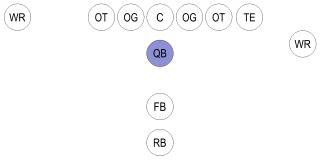
The quarterback, colloquially known as the "signal caller", is a position in gridiron football. Quarterbacks are members of the offensive platoon and mostly line up directly behind the offensive line. In modern American football, the quarterback is usually considered the leader of the offense, and is often responsible for calling the play in the huddle. The quarterback also touches the ball on almost every offensive play, and is almost always the offensive player that throws forward passes. When the QB is tackled behind the line of scrimmage, it is called a sack.

A touchdown is a scoring play in gridiron football. Whether running, passing, returning a kickoff or punt, or recovering a turnover, a team scores a touchdown by advancing the ball into the opponent's end zone. In American football, a touchdown is worth six points and is followed by an extra point or two-point conversion attempt.

Gridiron football, also known as North American football, or in North America simply football, is a family of football team sports primarily played in the United States and Canada. American football, which uses 11 players, is the form played in the United States and the best known form of gridiron football worldwide, while Canadian football, which uses 12 players, predominates in Canada. Other derivative varieties include arena football, flag football and amateur games such as touch and street football. Football is played at professional, collegiate, high school, semi-professional, and amateur levels.

In gridiron football, an onside kick is a kickoff deliberately kicked short in an attempt by the kicking team to regain possession of the ball. This is in contrast with a typical kickoff, in which the kicking team kicks the ball far downfield in order to maximize the distance the receiving team has to advance the ball in order to score. The risk to the team attempting an onside kick is that if it is unsuccessful the receiving team gets the ball and usually has a much better field position than with a normal kickoff.

Glenn Scobey Warner, most commonly known as Pop Warner, was an American college football coach at various institutions who is responsible for several key aspects of the modern game. Included among his innovations are the single and double wing formations, the three point stance and the body blocking technique. Fellow pioneer coach Amos Alonzo Stagg called Warner "one of the excellent creators". He was inducted as a coach into the College Football Hall of Fame as part of its inaugural class in 1951. He also contributed to a junior football program which became known as Pop Warner Little Scholars, a popular youth American football organization.

The punt kick is a common style of kicking in Australian rules football. It is a kick where the ball is dropped from the players' hands and kicked slightly off the longer center line of the ball before it hits the ground. It is the primary means of kicking the ball in Australian football and is similar to punts used tactically in other football codes, such as American and Canadian football.
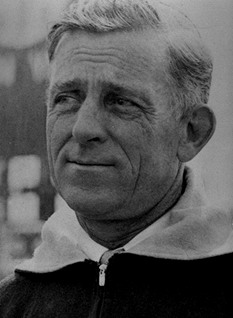
Charles Emile "Gus" Dorais was an American football player, coach, and athletic administrator.
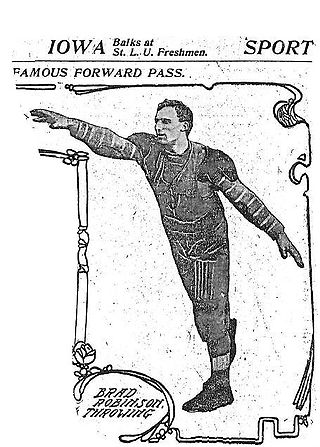
In gridiron football, a triple-threat man is a player who excels at all three of the skills of running, passing, and kicking. In modern usage, such a player would be referred to as a utility player.

Bradbury Norton Robinson Jr. was a pioneering American football player, physician, nutritionist, conservationist and local politician. He played college football at the University of Wisconsin in 1903 and at Saint Louis University from 1904 to 1907. In 1904, through personal connections to Wisconsin governor Robert M. La Follette, Sr. and his wife, Belle Case, Robinson learned of calls for reforms to the game of football from President Theodore Roosevelt, and began to develop tactics for passing. After moving to Saint Louis University, Robinson threw the first legal forward pass in the history of American football on September 5, 1906, at a game at Carroll College in Waukesha, Wisconsin. He became the sport's first triple threat man, excelling at running, passing, and kicking. He was also a member of St. Louis' "Olympic World's Champions" football team in 1904.
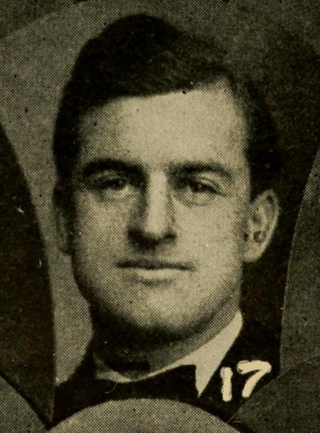
Edward Bulwer Cochems was an American football player and coach. He played football for the University of Wisconsin from 1898 to 1901 and was the head football coach at North Dakota Agricultural College—now known as North Dakota State University (1902–1903), Clemson University (1905), Saint Louis University (1906–1908), and the University of Maine (1914). During his three years at Saint Louis, he was the first football coach to build an offense around the forward pass, which became a legal play in the 1906 college football season. Using the forward pass, Cochems' 1906 team compiled an undefeated 11–0 record, led the nation in scoring, and outscored opponents by a combined score of 407 to 11. He is considered by some to be the "father of the forward pass" in American football.

Howard Roland "Bosey" Reiter was an All-American football player, coach and athletic director. He was selected for the 1899 College Football All-America Team and played professional football as a player coach for the Philadelphia Athletics of the first National Football League in 1902. He was the head football coach at Wesleyan University from 1903 to 1909 and at Lehigh University from 1910 to 1911. Reiter has been credited by some with the development of the overhand spiral forward pass, which he claimed to have developed while playing for the Athletics in 1902.
The following terms are used in American football, both conventional and indoor. Some of these terms are also in use in Canadian football; for a list of terms unique to that code, see Glossary of Canadian football.
Paul Lansing Veeder was an All-American football player for Yale University. Veeder played halfback, fullback, quarterback and punter for the Yale Bulldogs from 1904–1906 and was selected as an All-American in 1906.

In gridiron football, a punt is a kick performed by dropping the ball from the hands and then kicking the ball before it hits the ground. The most common use of this tactic is to punt the ball downfield to the opposing team, usually on the final down, with the hope of giving the receiving team a field position that is more advantageous to the kicking team when possession changes. The result of a typical punt, barring any penalties or extraordinary circumstances, is a first down for the receiving team. A punt is not to be confused with a drop kick, a kick after the ball hits the ground, now rare in both American and Canadian football.
The 1883 Princeton Tigers football team represented the College of New Jersey, then more commonly known as Princeton College, in the 1883 college football season. The team finished with a 7–1 record and outscored opponents 238 to 26, using the new scoring rules introduced by Walter Camp. The Tigers won their first seven games before losing the final game of the season to Yale in New York.

Herman Peter Hauser was a United States Native American football player. He played for the Haskell Indians football team from 1904 to 1905 and for the Carlisle Indians football team from 1906 to 1910 and was selected as a consensus first-team fullback on the 1907 College Football All-America Team. He was a multi-talented player who ran with the ball, handled place-kicking and punt returns, and has been credited as the first player in American football to throw a spiral pass.
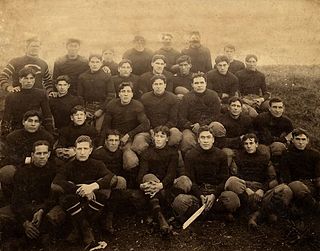
The 1907 Carlisle Indians football team represented the Carlisle Indian Industrial School as an independent during the 1907 college football season. Led by sixth-year head coach Pop Warner, who returned after having helmed the team from 1899 to 1903, the Indians compiled a record of 10–1 and outscored 267 to 62.

The early history of American football can be traced to early versions of rugby football and association football. Both games have their origin in varieties of football played in Britain in the mid–19th century, in which a football is kicked at a goal or run over a line, which in turn were based on the varieties of English public school football games.